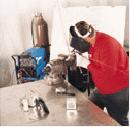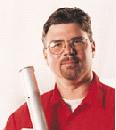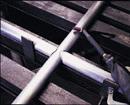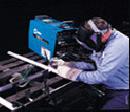
For TIG welding aluminum, these fabricators report that nothing surpasses Advanced Squarewave technology
Dennis Schlieckau and Bill Means never met, but they fought the same battle.
Schlieckau designs and welds small, thin aluminum components for an airplane equipped with a parachute, while Means fabricates architectural railings from schedule 40 aluminum tubing. In these very different uses, they faced a common enemy: the limitations of their TIG welding machine. In certain aluminum applications - notably fillet welds, small parts and material thinner than .050 in. - conventional AC TIG technology forced Schlieckau and Means to fight arc wandering, difficult-to-control weld puddles and unnecessarily wide beads.
Fortunately, they also found a common solution in the Advanced Squarewave output provided by an AC/DC TIG inverter, the Dynasty 300 DX from Miller Electric Mfg. Co. After converting to a TIG inverter, Schlieckau could weld a gusset in the plane's rudder system made from .032 in. aluminum. "I don't think I could weld the gusset with a conventional TIG unit," says Schlieckau, "because of arc instability and arc wandering when welding at 22 amps on a fillet weld." Means states that since switching to an inverter "I've cut welding time by 25 to 30 percent. My bead is about 25 percent narrower, and I estimate post-weld grinding and polishing time is 15 percent less."
Revitalizing General Aviation
Schlieckau, R&D and Welding Specialist, works for Cirrus Design Corporation, a designer and manufacturer of personal and business aircraft with headquarters at the Duluth International Airport. The company is single-handedly revitalizing general aviation with its Cirrus SR20. This four-place, single-engine aircraft offers a 160-knot cruise speed, the comfort of a luxury sedan, easy-to-operate controls, multi-function instrumentation and a parachute that can decrease the plane's rate of impact to the point of making it survivable.
"We've tried to take the intimidation out of flying," says Chris Maddy, Cirrus' Communications Director. "People assume that flying requires a skill they cannot obtain, yet flying is actually easy to learn. The SR20 encourages people to fly because we designed it to address what the consumer wants, such as a better view of the horizon, easier handling controls, noise-canceling headsets and comfortable seating."
Although Cirrus builds the SR20's fuselage, single-spar wing, elevator, rudder, stabilizers and flaps from glass fiber composites, many of the plane's subcomponents require welding.
"For a company like ours, where we currently produce one plane every two and a half days, sourcing components can be difficult," says Schlieckau. "The tooling for an injection molded or stamped item costs tens of thousands of dollars. We save money by fabricating low-volume metal components ourselves rather than outsourcing them."
The SR20 uses approximately 50 TIG welded parts, including the engine mount, nose landing gear, pan assembly, battery bracket and tie-down brackets, all made from 4130 chrome-moly. The exhaust system is made from 321 stainless.
Because a lighter plane uses less fuel and flies faster, Cirrus employs 6061 aluminum wherever possible, even for small parts (see photo). Aluminum components include the rudder gusset, brake fluid reservoir, baggage door hinges, door mounts, drain manifold, HVAC/heating system control rod, torque tube assembly for pitch control and a compression tube. This last component, a .083 in. wall, 2 in. diameter tube mounted across the front of the fuselage, prevents the airframe from collapsing during parachute deployment.
Total Puddle Control
While aluminum comprises just 5 percent of Cirrus' metal use, the company readily justified investing in an AC/DC TIG inverter.
"As soon as I tried the Dynasty," says Schlieckau, "I said to our purchasing agent 'I need this.' With regular TIG units, I never could control the weld puddle like I wanted to. I still had to use a pure, balled tungsten, and the arc danced a lot. Try as I might to make a nice, fine bead, I could not do it. The bead always ended up twice as wide as I wanted."
Cirrus Welding Operator Sean Senarighi adds that "controlling the puddle was quite difficult with our old units. The arc wandered, so I couldn't put the heat where I wanted." On thin aluminum, excessively large beads and arc wandering may add more heat than the material can support, resulting in burn through or warping. On any thickness of material, they waste time, filler wire, tungsten and shielding gas because the operator cannot weld efficiently.
"Once I converted to an inverter with Advanced Squarewave technology," Schlieckau continues, "I could weld aluminum at a higher frequency [see story in tint box] with a sharpened, 2 percent thoriated tungsten. Unlike a balled tungsten, a pointed electrode enhances arc control and directs the heat more precisely at the joint. This minimizes distortion and bead width. Looking at my bead width now, it's almost hard to tell the difference between aluminum and steel."
Senarighi agrees, noting that "the way the aluminum puddle flows, it has similar characteristics to welding steel. I have control of the heat, so I can place the weld bead where I want it."
Seamless Railings
Bill Means also notices different operating characteristics. "With the inverter's concentrated arc, I can start welding almost immediately," he says. "I don't have to wait while the material heats up to a weldable temperature. Basically, I step on the foot control and begin adding filler rod."
Means functions as Team Leader for Indiana Gratings, Inc., Martinsville, Indiana. The company mainly produces industrial flooring but branched out into the non-ferrous railing business in the mid-1980s because customers wanted a second resource for architectural-grade handrails. Railings from Indiana Gratings grace places like the River Downs Racetrack in Cincinnati, the University of Kentucky in Lexington, the Kennedy Center in Martinsville and high schools throughout Indiana and Illinois.
Indiana Grating fabricates railings from 1 1/2 and 1 1/4 in. diameter tubing made from 6063 aluminum (schedule 40), stainless (schedule 10) and brass (schedule 5). Prior to welding, operators cut, cope and bevel the tubing to ensure good penetration. After welding, all joints are ground and polished to a mirror finish (#4 finish) so that one piece of metal flows seamlessly into another.
Like Cirrus, Indiana Grating readily justified investing in Advanced Squarewave technology.
"The smoother the weld we can put in the joint, the less time we'll have to spend finishing it," says Doug Maginn, Vice President of Indiana Gratings.
Because the Advanced Squarewave arc provides superior puddle control, even average operators can create a better looking, narrower bead that requires less finishing (see photo). Means notes that one of the company's operators isn't as adept at welding aluminum as the others, who use conventional TIG machines. "However, when he welds with the Dynasty, his beads are comparable to ours," he says. "An inverter makes an average operator a better one."
Means estimates that the Advanced Squarewave arc creates a bead 1/4 to 3/8 in. wide on schedule 40 tubing, where a conventional AC TIG arc creates beads about 25 percent wider.
"Because the Dynasty enables me to create a more focused and stable arc," he says, "less heat goes into the area surrounding the root. This results in a smaller bead with much better penetration. I notice that I'm using less filler rod, too."
Lightning Payback
Although AC/DC TIG inverters with an Advanced Squarewave arc demonstrate clear benefits, some fabricators hesitate to purchase them because of price. However, a return-on-investment calculation proves that an inverter makes much better economic sense in the right applications.
For example, Miller Electric's Syncrowave® 250 probably the world's best selling traditional AC/DC TIG machine has a list price of $2,457. Because inverters require more expensive materials, the Dynasty costs $4,605. However, the cost difference evaporates quickly because inverters 1) establish the weld puddle much faster, 2) increase travel speeds, 3) reduce welding and post-weld finishing time and 4) lower tungsten, gas and filler wire consumption.
Indiana Gratings conservatively reduces welding time by 25 percent with the Dynasty, so a 40-hour project now takes 30 hours. This creates the potential to bill an additional 10 operator-hours per week or, alternatively, raise billing rates by 25 percent. If a fabricator charges customers $35/hour for TIG services (a common industry rate), the Dynasty can increase profitability by $350 per week. In less than seven weeks, the benefits of Advanced Squarewave technology wipe out the cost difference between a Syncrowave and a Dynasty. Complete payback occurs in about 13 weeks, which eclipses the two-year time frame many purchasing agents use for this type of equipment.
Dennis Schlieckau, who started as Cirrus' first employee 14 years ago, has welded airplanes with every type of technology: oxy-acetylene, a Miller AC/DC Thunderbolt®, the Syncrowave 250 and the Dynasty.
"When we got our Syncrowave ten years ago, it was the Cadillac of TIG welders; it's still an excellent machine," he says. "However, the benefits you gain when welding aluminum more than outweigh the cost of upgrading to a Dynasty. For better arc control and control over the bead width on aluminum, we prefer Advanced Squarewave technology."
The Dynasty provides superior control on aluminum because its inverter technology permits controlling the shape and force of the arc cone. Think of an inverter like adding a nozzle to a fire hose. It lets you change the shape and force of the "water" (welding current) from a wide fan to a focused stream. But instead of turning a nozzle, you adjust output frequency. Frequency, or Hz, is the number of times the AC arc switches between electrode positive and electrode negative in one second. The Dynasty permits adjusting frequency from 20 to 250 Hz, where a conventional TIG machine has an output fixed at 60 Hz. Frequencies of 60 Hz or less create a broader arc cone and transfer more energy to the work. This is an ideal combination for build-up or to catch both edges of an outside corner while main-taining travel speeds. However, it also results in arc wandering on fillet welds. The arc dances from plate to plate, so the puddle starts at the toes of the weld and flows toward the center. This almost compels operators to over-weld to ensure penetration at the root, forcing them to waste time and materials. Fortunately, increasing the frequency ("constricting the nozzle") narrows the shape of the arc cone and increases arc force. This stabilizes the arc, reduces arc wandering and provides excellent directional control over the arc and weld puddle (which is why many operators say it reminds them of welding steel with a DC arc). On lap and T-joints, higher frequencies - like the 140 to 160 Hz used by Cirrus operators - provide maximum control over the flow and width of the weld puddle. Operators can direct the arc right where they want it, establish the weld puddle faster and precisely place the filler wire. This prevents the burn through and warping that might occur on thin material, and it reduces welding time on any job.
© 2002 Miller Electric Mfg. Co


